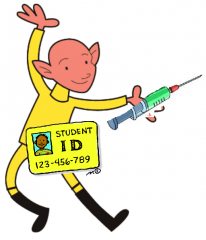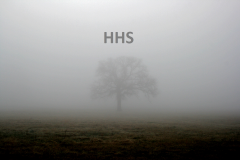![]()
![]()
![]()
Use LEFT and RIGHT arrow keys to navigate between flashcards;
Use UP and DOWN arrow keys to flip the card;
H to show hint;
A reads text to speech;
56 Cards in this Set
- Front
- Back
|
management of haemorrhagic shock |
1. IV fluids + trigger haemorrhage protocol 2. Blood - O neg - FFP + packed red cells (1:1) 3. further FFP + RBC (4:6) 4. consider cyroprecipitate 5. consider platelets |
|
|
non life threatening acute transfusion reactions |
mild fever - give paracetamol urticaria - give chlorphenamine |
|
|
presentation of severe allergic reaction after transfusion |
bronchospasm, angioedema, abdominal pain, hypotension |
|
|
causes of acute dyspnoea / hypotension after transfusion |
fluid overload (raised CVP) - give oxygen and furosemide TRALI (normal CVP, LV failure, fever) - give 100% oxygen and ventilate |
|
|
management of anaphylactic shock |
1. High flow oxygen 2. Adrenaline 1:1000 500µg IM 3. IV fluid challenge 4. Anti-histamine - chlorphenamine 10mg IM/IV 5. Steroids - hydrocortisone 200mg IV |
|
|
management of cardiogenic shock (tachycardia + hypotension) |
1. synchonised DC shock up to 3 attempts 2. amiodarone 300 mg IV over 10-20 mins 3. repeat shock 4. amiodarone 900 mg IV over 24 hours |
|
|
management of bradycardia + shock |
atropine 500µg IV (can repeat to maximum of 3 mg) arrange transvenous pacing |
|
|
causes of cardiac tamponade |
pericarditis aortic dissection Haemodialysis Warfarin transseptal puncture at cardiac catheterization post cardiac biopsy |
|
|
signs of cardiac tamponade |
tachycardia hypotension pulsus paradoxus raised JVP Kussmaul's sign muffled heart sounds |
|
|
Beck's triad in cardiac tamponade |
falling BP rising JVP muffled heart sounds |
|
|
investigations for cardiac tamponade |
CXR: big globular heart ECG: low voltage QRS ± electrical alternans Echo: for tamponade |
|
|
define delirium |
acute confusional state caused by a physical condition |
|
|
causes of delirium |
Infection/Sepsis Hypoxia Pain Dehydration Metabolic / electrolyte imbalance Constipation / Bladder retention Drug withdrawal including alcohol Stroke Exacerbation of medical condition - hypothyroidism, dementia |
|
|
features of delirium on confusion assessment method |
1. acute and fluctuating course 2. inattention 3. disorganised thinking 4. altered level of consciousness |
|
|
presentation of DKA |
polyuria, polydipsia nausea / vomiting abdominal pain altered mental status signs of dehydration |
|

causes of DKA |
IMPS ID Inadequate or inappropriate insulin therapy MI Pancreatitis Stroke Infection Drugs - corticosteroids, sympathomimetics, thiazides, second-generation anti-psychotics, and cocaine |
|
|
DKA diagnostic criteria |
Plasma glucose >13.9mmol/L Arterial pH <7.3 Presence of ketonaemia and/or ketonuria |
|
|
management of DKA |
1. Fluid resuscitation - (1) 1L 0.9% NaCl then (2) 5L NaCl+ KCl over 20hrs then (3) 5% detrose when glucose <15mmol/l 2. Insulin infusion - rate based on weight, at a fixed dose 3. Monitoring - capillary glucose + ketones, neurological status, fluid-balance, VBG for pH, Na+, K+ |
|
|
complications of DKA |
hypoglycaemia potassium abnormality fluid overload |
|
|
diagnostic features of hyperglycaemic hyperosmolar state (HHS) |
Raised plasma glucose (>33.3 mmol/l) Raised serum osmolality (330 mmol/kg) Absence of severe ketoacidosis |
|
|
presentation of HHS |
altered mental state dehydration abdominal pain |
|
|
management of HHS |
1. 0.9% NaCl to reverse dehydration 2. Low dose IV insulin should only be commenced once the blood glucose is no longer falling with IV fluids alone 3. Identify and treat underlying precipitants 4. thromboprophylaxis |
|

precipitants for HHS |
MIST: Myocardial infarction infection stroke trauma |
|
|
complications of HHS treatment |
Fluid overload Cerebral oedema Central pontine myelinosis |
|
|
presentation of Addisonian crisis |
hypovolaemic shock Hypoglycaemia Hyponatraemia Hyperkalaemia |
|
|
precipitating factors for Addisonian crisis |
Infection, trauma, surgery, missed medication |
|
|
initial management of Addisonian crisis |
IV fluid bolus High dose hydrocortisone - 100mg IV stat. Treat the precipitant e.g. antibiotics if concern about infection Monitor electrolytes and glucose |
|

symptoms & signs of severe hypothermia |
CAB HAG Confusion Agitation Bradycardia Hypotension Arrhythmias (AF, VT, VF), esp if temp <30°C GCS - reduced/coma |
|
|
management of poisoning |
1. ABCDE 2. Decontamination - activated charcoal 3. elimination - urinary alkalinsation / haemofiltration 4. antidotes 5. Observe - for 6 hours |
|
|
management for aspirin overdose with high salicylate concentration |
1. give sodium bicarbonate 2. Haemodialysis |
|
|
antidote for TCA overdose |
sodium bicarbonate |
|
|
indications for N-acetylcysteine use |
8-24 hours since ingestion & blood paracetamol concentration > 150mg/kg 24-36 hours since ingestion & clearly jaundiced or hepatic tenderness Staggered overdose uncertain time of ingestion &dose ingested is ≥150mg/kg in 24 hours |
|
|
Management of carbon monoxide poisoning |
1. ABG 2. 100% oxygen 3. if severe, mannitol 4. ECG |
|
|
approach to aortic dissection |
Immediate thoracic CT or TOE (TTE shows type A only) Classify dissection according to Stanford classification Emergency surgical repair unless type B |
|
|
Stanford classification of aortic dissection |
type A dissections involve the ascending aorta type B dissections do not involve the ascending aorta. |
|
|
signs of accelerated hypertension |
"Really severe hypertension produces AKI normally" severe hypertension retinal hemorrhages papilloedema heart failure neurologic disturbance acute kidney injury |
|
|
management of accelerated hypertension |
low reduction of BP with: 1. Labetalol 2. Nitroprusside (contraindicated if raised ICP) 3. Nicardipine (contraindicated in renal failure) 4. fenoldopam |
|
|
initial management of cardiac arrest |
1. Check response, pulse and airway. If no response, call resus team 2. No pulse? → Start CPR 3. Assess rhythm A. Shockable = VF / pulseless VT → shock B. Non-shockable = PEA / asystole → CPR |
|
|
management of VF or pulseless VT |
Shock 1 Immediately resume CPR for 2 mins Shock 2 Immediately resume CPR for 2 mins Give adrenaline 1mg IV Shock 3 + give amiodarone with 3rd shock |
|
|
management of asystole / PEA |
CPR Give adrenaline 1 mg IV every 3 – 5 min |
|
|
Potential reversible causes of cardiac arrest |
Hypoxia Hypovolaemia Hypo/hyperkalaemia & metabolic disorders Hypothermia Tension pneumothorax Tamponade, cardiac Toxins Thrombosis (coronary or pulmonary) |
|
|
Complications after surgery for a perforated viscus |
Wound infection Wound dehiscence Chest and other infections Abdominal abscess Multi-organ failure / septic shock Renal failure |
|
|
treatment for post-surgical intra-abdominal sepsis |
Piperacillin-tazobactam (Tazocin) 4.5g IV TDS + metronidazole 400mg PO TDS Treat for 3-7 days, review IV daily |
|
|
causes of an acute abdomen |
Appendicitis pancreatitis peptic ulcer perforated viscus abdominal aortic aneurysm complications of gallstones intestinal obstruction renal colic pyelonephritis diverticulitis ectopic pregnancy salpingitis (PID) ruptured ovarian cyst |
|
|
Techniques for assessment of size of a burn |
1% Rule - patient's hand = 1% of surface area Wallace Rule of 9s / Rule of 5s Lund & Browder Chart |
|
|
Complications of burns |
Immediate - Smoke inhalation, compartment syndrome (if circumferential burns) Early - Hyperkalaemia, acute renal failure, infection, stress GI ulceration Late - Contractures |
|
|
Major trauma 'B' killers |
tension pneumothorax open pneumothorax flail chest massive haemothorax |
|
|
cause of flail chest |
≥2 ribs fractured in ≥2 places with paradoxical motion of the chest wall |
|
|
complications of flail chest |
pneumothorax haemorthorax pulmonary contusion |
|
|
AMPLE history |
Allergies, medications, PMH, last meal, events |
|
|
indications for CT head scan within 1 hour after head injury |
GCS < 13 on initial assessment GCS < 15 after 2 hours suspected open or depressed skull fracture any sign of basal skull fracture post-traumatic seizure focal neurological deficit >1 episode of vomiting |
|
|
signs of base of skull fracture |
Panda eyes haemotypanum = presence of blood in the tympanic cavity of the middle ear otorrhoea/rhinorrhoea = isolation of fluid from the ears / nose Battle’s sign = ecchymosis (bruise) around the mastoid process from head trauma that has caused a temporal bone fracture |
|
|
investigation after head injury for patients on warfarin |
if risk factors, CT head scan within 1 hour if no risk factors, CT head scan within 8 hours |
|
|
extradural haematoma on CT & neurosurgical management |
biconvex shape - due to middle meningeal artery damage, if temporal-parietal Management: craniotomy andevacuation of clot, admit to NICU |
|
|
subdural haematoma on CT Management if chronic |
Cresenteric appearance on CT (tearing of bridging veins) If acute: craniotomy and clot evacuation If chronic: May not need to operate as brain atrophy allowsfor compensation + elderly patients are not suitable for craniotomy& ICU Consider borehole (less riskythan craniotomy) |
|
|
management of intracerebral haemorrhage |
lower ICP - raise head to 30 degrees, mannitol, hyperventilation, hypertonic saline neurosurgery - to drain haematoma |

